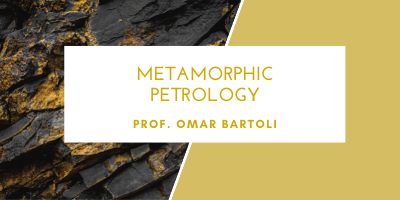Metamorphic Petrology

Period: second semester
Course units contents:
The course will provide deep insight into the main aspects of metamorphic petrology, such as:
- Metamorphism: review of the basic concepts (definition and limits of metamorphism, factors controlling metamorphism, metamorphic grade, concept of metamorphic facies, types of metamorphism)
- Equilibrium assemblages and metamorphic reactions
- Chemographies and other graphical representations
- Metamorphism of metapelites and metabasites
- High-temperature metamorphism and anatexis (migmatites)
- Microstructures of anatectic rocks (evidence of partial melting)
- Thermodynamics, geothermobarometry, phase equilibria calculations
- Melt and fluid inclusions in metamorphic rocks
- Mobility of critical elements during metamorphism
Planned learning activities and teaching methods:
Theoretical notions will be transferred by means of frontal lessons with multimedia material that will be provided beforehand to students.
The organization of the class includes lecture, practice at the microscope, computer modeling (including problem solving) and field activity.
Laboratories will consist of a) practicals assisted by the teacher at the petrographic microscope, using selected thin sections; b) phase equilibria modelling (using Perple_X software). Microscope activity and computer modeling will be mostly focused on IVZ rocks.
The area selected for the fieldwork is the Ivrea Verbano Zone (IVZ), which is a well-preserved Permian lower crustal section. Students will have the opportunity to work on outcrops of the Mafic Complex and, in particular, of amphibolite to granulite facies rocks of the Kinzigite formation.
Both frontal lessons and practicals include parts of teacher-student dialogue as well as of work in small groups with the aim of verifying the acquired.
In addition to contacting the course instructor, students with disabilities, Specific Learning Disorders (SLD), Special Educational Needs (SEN), and other health conditions can reach out to the Student Services Office - Inclusion Unit to receive more information about opportunities to access teaching with specific support and tools.
